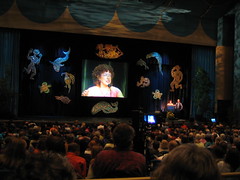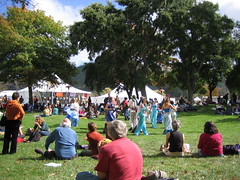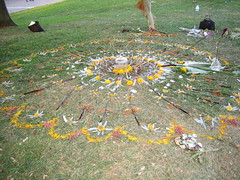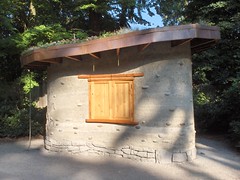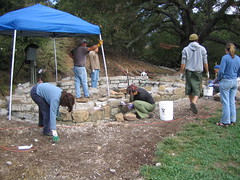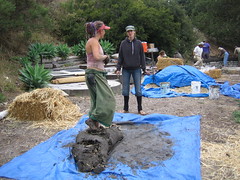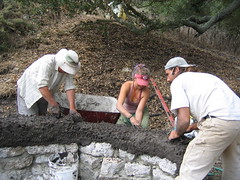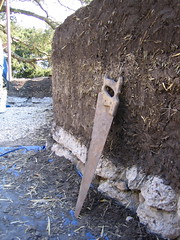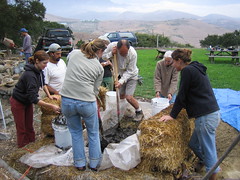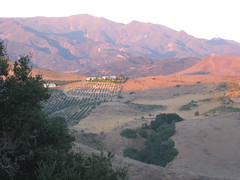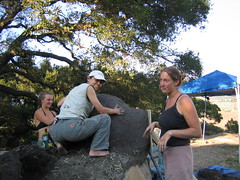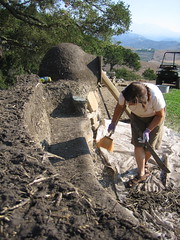The Power of Stories
Two back-to-back events, a documentary on the origins of Al Qaeda (you did want to know, didn't you?) and the 16th annual Bioneers conference pose questions of how we choose to embrace stories of fear or stories of healing. Is it a matter of framing or can we just change channels already?
A recent transplant from Manhattan exclaimed over lunch, that she was so glad to be out of New York because all the terror alerts had her in a constant state of anxiety. I was surprised at the comment because even mainstream journalists had made the connection between terror alerts and political events. For instance the bomb plot against the New York City subway system came just after Bush's plea to continue the war against terrorism, not to mention the need to distract the public from the investigation of Karl Rove. Wasn't it clear that we were being manipulated?
"I just want all the bad guys taken out," she went on to say. Bad guys? Was this a Western? Why are we still going along with this good versus evil story? Why are unrelated incidents, whether a squabble in the south of Thailand or a suicide bomber on the West bank, now being connected, as if these largely poor, disenfranchised troublemakers were heeding orders from a single source? Would a street gang in L.A. be on a conference call with a gang in New York to discuss what crime would increase the terror alert ratings?
Many of these questions were answered for me, by a BBC documentary called "The Power of Nightmares" (shown at the Unitarian church as part of their Peace and Justice film series. It was broadcast twice on prime time television to the British public, but not to us). Going back a number of decades this narration knits together a trail of fear mongering.
It seems that a handful of young idealists studying under a certain professor named Leo Strauss, had come to the conclusion that Americans needed a galvanizing story to counter the degenerate affects of the social liberation movement of the 60's. This movement, they believed, would eventually tear society apart and we would all end up in a writhing, flesh pit of homo erotic, selfish gluttony and immorality, having forgotten how to tell good from evil.
These men were to gain political influence at the national level during the Reagan administration, where they began a campaign of fear about how the Soviets were planning to attack us. When no evidence could be produced of such plans, they claimed that the Soviets were so advanced in their weaponry that, what surveillance we had, would not be able to detect them. That's right, no evidence, not then, not now, not ever.
Such a story, despite being a bald faced lie, justified their greater goal to inspire the American people to engage in a clear cut fight between good and evil, which would, they believed, restore morality to American culture, and incidentally further their power to control world resources.
I did recognize a few of their names - Rumsfeldt and Paul Wolfowitz, joined by Chenney and Richard Perle from the Pentagon. They wrote their neo-conservative treaties, the Plan for a New American Century (PNAC). I first heard of PNAC from an article in the New York Times in '03, but I had not, until now, been exposed to their earlier work conjuring up the Red Scare.
Spurred on by the fall of the Soviet empire, which they considered a personal victory against evil (rather than a rethinking of empire on the part of the Russians), these PNACkers figured they had a winning strategy and they created for us another round of inspiring lies to launch the fight against terrorism. This time it was an international organization of terrorists called Al Qaeda.
Here's how Al Qaeda was invented. A fringe group of fanatics in the Islamist movement, who were also motivated by their disgust at the degenerate, cultural liberalism being projected by America, decided that they too, would like to purge this evil from the face of the earth by attacking symbols of the West. They turned to the like-minded Osama Bin Laden to finance them. Flush with Saudi family money, bin Laden was Mr. Money Bags for Muslim fanatics who wanted to attack the West.
After the bombings of American embassies, four men were captured, but not bin Laden. They were sent to Manhattan for prosecution. In order to prosecute bin Laden under U.S. laws designed to convict Mafia bosses, he had to be proven to be the head of a bonafide organization. An ex-associate of bin Laden was groomed by the Americans, with money and protection, to give evidence of this organization. Said evidence was more wishful thinking and myth making than reality. It was this witness who gave bin Laden's group the name Al Qaeda.
As the events of 9/11 unfolded, the neo-conservatives fell back on the Al Qaeda story. Bin Laden, who had never claimed the name before, saw this moniker as his opportunity to elevate his fringe status to that of dreaded enemy of the Americans. He was happy to take the credit for 9/11 even though he had not planned it, just given money to an Islamist militant, named Khalid Sheik Mohammed, who asked him to fund his attack on the Americans.
And when American troops combed Afghanistan for the Taliban, a price was given for every Taliban captured and most were. And since the U.S. was also looking for Al Qaeda terrorists, local warlords were said to be kidnapping any available Arab-looking male and claiming they were Al Qaeda terrorists for the bounty the Americans would pay them.
Visions of a secret, James Bond style, evil guy's headquarters, danced in the collective imagination. The Madrid train bombing, the London subway bombings and every other unrelated terrorist incident since, were all claimed to be linked to Al Qaeda. But poke around a little and the whole story falls apart. It's a self-serving neo-con fantasy. (Transcripts here.)
Aren't you tired of this "get the evildoers" plot? Don't you just long to go to a parallel universe of love and we-can-talk-this-out goodwill, because all life is sacred and all religions everywhere basically are saying the same thing - stop right now and appreciate this great awesome, creation called life. But no, we are intent on proving that fear gets people motivated and love is just well, lame.
If we are going to live in a climate of fear, I felt we should, at least, have something bonafide to fear. That was the allure of the Bioneers conference we attended the following day. I had heard that this was where the bad news of the environment was delivered, straight from the mouths of scientists and ecologist foot soldiers.
So were environmentalists indulging in a form of fear mongering too?
America was definitely writhing in the flesh pit of consumerism. One speaker, Tom Hartman, came right out and said that the word 'consumer' was a way to infantilize us. To keep our focus on our gluttonous appetites of "I want" like babies sucking on a bottle and crying for more. The word citizen, he pointed out, described active participants in the community working to shape a better world for humanity.
I had already rejected the label consumer, but when I heard the word infantilize, it was a revelation. He had dared to say outright that this was not just a lifestyle choice between being a citizen and being a consumer; this consumer thing was a diversion of our proper journey to adulthood, an out and out plot to keep us from taking our full power as whole beings.
"Go shopping," was what our president asked of us in the fight against terrorism. What a cunning strategy, just give us a passive activity, not one that had us using our minds to assess the situation and spring into action. That would be too empowering. Better that we passively watch the terrorist alerts and live in constant anxiety. People in a state of fear could be counted on to buy security at any price -military intervention, restricted rights, compromised quality of life.
Bioneers offered an antidote to fear. There were no sentiments spoken about how dire the situation had become with the Bush regime and the melting polar caps. These thoughts were given only a passing reference in the form of jokes. To laugh was the best medicine. Humor would see us through, give us distance from overwhelming information and emotional paralysis. (Dance, too, and art and music.)
And while a consumer's good vs. evil story, might frame corporations as evil for whatever reason, to be attacked with a consumer boycott (the weakest of weapons), Bioneers had a better defense.
One of the speakers, Carolyn Raffensperger, introduced us to the precautionary principle. She had just published a new book with a colleague, called Precautionary Tools for Reshaping Environmental Policy.
(Perversely, the neo-cons had stolen the precautionary principle to justify the taking out of "all the bad guys" to prevent them doing harm through terrorist acts. This gave us the premise for pre-emptive strikes).
The precautionary principle actually came out of the pollution prevention movement of the 70's that aimed to stop companies from releasing harmful substances into the biosphere. The principle establishes that it should not have to be the public's responsibility to prove that substances are harmful. The burden of proof should be shifted to those producing the substances. Companies should have to prove that their products are harmless before it is allowed on the market.
What we have been doing is allowing thresholds of harmfulness. A few dead lab rats are okay, just not a critical mass for any one substance. We know, now, that accumulations of small amounts of a variety of chemicals, can quickly compromise our immune systems, hormonal systems and respiratory systems.
San Francisco was the first U.S. city to embrace the precautionary principle into law in June of 2003. Thus if a pesticide is found to be harmful, it simply isn't allowed on public property. There don't you feel better? Here is a potent way to fortify ourselves from large, powerful corporations.
Government is one of the tools of a citizen. The consumer boycott is but an army of individuals paddling canoes out to sea to fight a giant. Government is the means to change the sea itself, to restrain the giant.
Another speaker, a young black man from the South Bronx spoke of a citizens group that had formed to seek solutions to environmental injustice, particularly the dumping of waste in their neighborhoods. They created a local workers' cooperative to collect construction waste and offer it for sale. This empowered local people through their jobs, reused resources and put a dent in the impact of the dumpsites.
A man from L.A. told of his outreach work to kids to teach recycling. The kids were given materials to take home to demonstrate how recycling worked. When the city followed with a recycling program they had 90% participation. Having learned how to reach the community through its children, the same team, called the Tree People, empowered a school to figure out how to bring trees to their solid cement play yard. Kids with megaphones would teach the city government how to collect rainwater in giant cisterns that would then filter the water for use locally, thus saving the city millions of dollars in storm water management and offsetting the millions spent to pipe more water in. City management would have never come up with such a solution because the storm management department and the water department were funded by different sources and forbidden to communicate. This man's cooperative vision bridged that gap.
My favorite story of solutions created to better our lives on a systems wide basis, was the story of how "living machines" could turn sewage into clean water inside giant greenhouses. This water treatment method produced multiple streams of income. The plant could sell expensive koi fish (fed on the sewage), flowers from the tropical plants that did the work of the living machine, protein for animals from the duckweed grown, methane to power the system and fertilizer for farms.
Just listening to these solutions allowed my brain to transform information that might otherwise overwhelm me and lead to fear. The stories of collaboration with nature and cooperation between citizens and government filled me with inspiration. Never mind that the examples were as yet small, this was the parallel universe of love I wanted to live in.
Also posted at energy bulletin.
